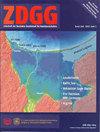Reconstructing fluvial landscape evolution using terrestrial cosmogenic nuclide dating: achievements, limitations and applications
IF 1.1
4区 地球科学
Q3 GEOSCIENCES, MULTIDISCIPLINARY
Zeitschrift Der Deutschen Gesellschaft Fur Geowissenschaften
Pub Date : 2017-03-01
DOI:10.1127/ZDGG/2016/0062
引用次数: 1
Abstract
Over the last three decades, theoretical and technical developments have considerably fostered and intensified the use of terrestrial (or in situ) cosmogenic nuclides as a geochronometer in a variety of environments at the Earth’s surface for the Late Cenozoic. These dating methods, including both surface exposure and burial dating, also significantly benefited to fluvial geomorphology. They opened new dating horizons for different kinds of fluvial archives at distinct time scales and thereby provided new insights into previously unanswered questions. This contribution aims at providing a concise (but not exhaustive) overview of these dating applications in a variety of fluvial environments (e.g. river terraces, alluvial fans, in cave-deposited alluvium). Therefore, it briefly presents the fundamental principles of both surface exposure and burial dating, together with a clear statement of the main methodological issues arising from the use of these methods in fluvial contexts. For each dating applications, key information about sampling procedures in the field and representative case studies are also provided.陆地宇宙成因核素定年法重建河流景观演化:成就、局限与应用
在过去的三十年里,理论和技术的发展大大促进和加强了陆地(或原位)宇宙成因核素在新生代晚期地球表面各种环境中作为地质年代测定仪的使用。这些测年方法,包括地表暴露和埋藏测年,也大大有利于河流地貌。他们在不同的时间尺度上为不同类型的河流档案开辟了新的测年视野,从而为以前未回答的问题提供了新的见解。这一贡献旨在简要(但不是详尽)概述这些测年应用在各种河流环境中(例如河流阶地、冲积扇、洞穴沉积冲积层中)。因此,它简要介绍了地表暴露和埋藏年代测定的基本原则,并明确说明了在河流环境中使用这些方法所产生的主要方法问题。对于每个测年应用程序,还提供了有关该领域采样程序的关键信息和具有代表性的案例研究。
本文章由计算机程序翻译,如有差异,请以英文原文为准。
求助全文
约1分钟内获得全文
求助全文
来源期刊
CiteScore
2.80
自引率
36.40%
发文量
21
审稿时长
>12 weeks
期刊介绍:
Zeitschrift der Deutschen Gesellschaft für Geowissenschaften - Journal of Applied and Regional Geology (ZDGG) is an international peer reviewed journal, which publishes, since 1848, original contributions and review papers from all disciplines of geoscience research, with emphasis on the geology of Europe and applied topics in the Earth sciences.

 求助内容:
求助内容: 应助结果提醒方式:
应助结果提醒方式:


